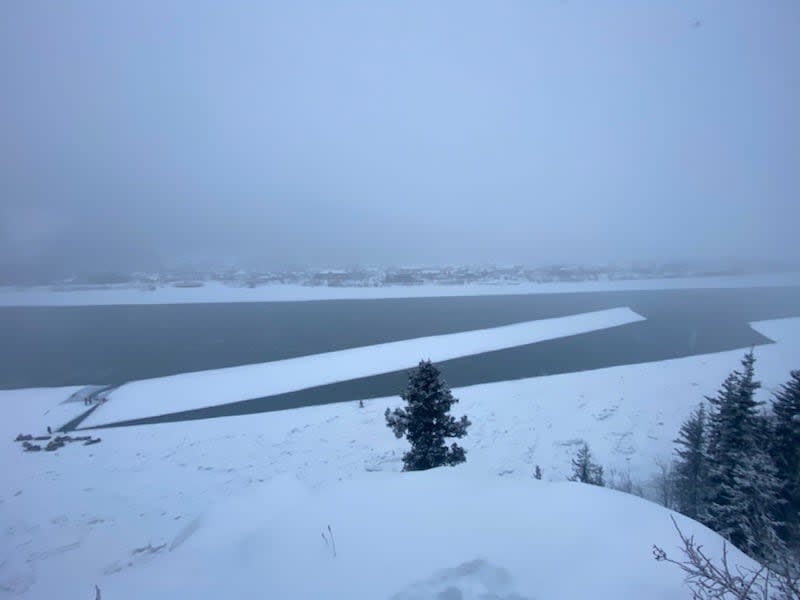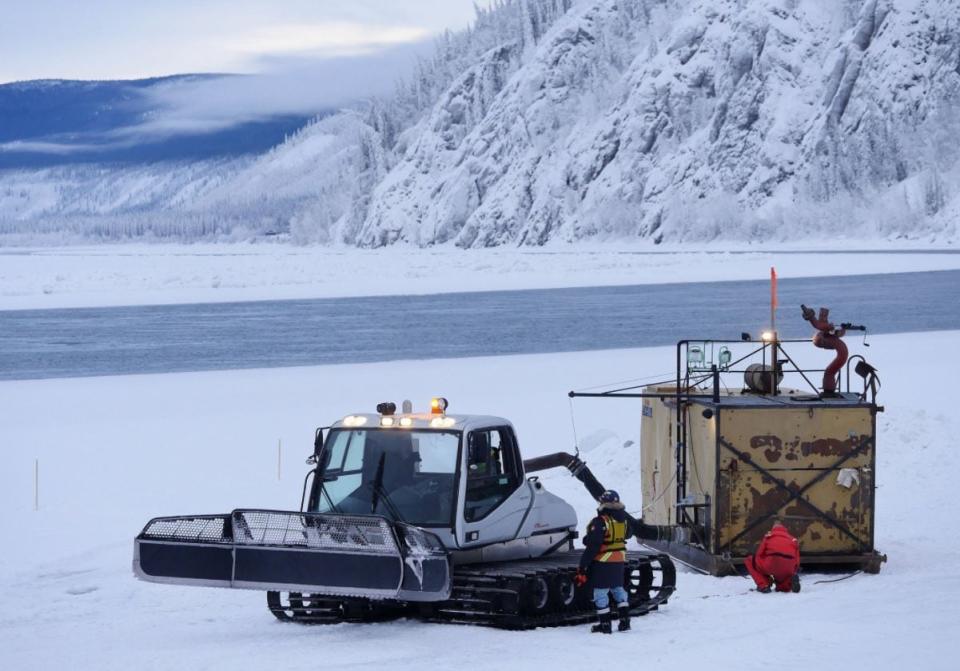Dawson City residents trying to build ice bridge watch their work float away

Residents of Dawson City, Yukon, have deployed chainsaws, axes and snowmobiles to build their own Yukon River crossings this winter — so far, with mixed success.
The town is still waiting for a government-sanctioned ice bridge that will provide road access between West Dawson and the main town site.
Most years, at the onset of winter, the river reliably freezes over on its own and the territorial government maintains a vehicle crossing between the ferry landings. But the river hasn't frozen over yet this winter.
Luke Wadey, with the territory's highways department, said warm weather, low water levels, and the formation of a sandbar upstream had hampered any progress on the ice bridge.
"There's still currently an open lead at the ice bridge location," he said. "Right now, we're just kind of waiting for the cooler weather to come in."

The Yukon River where the official ice bridge is normally constructed each winter, pictured here in 2018. Some residents this winter have been using a 5-kilometre trail to cross the river at an ice jam upstream. (Government of Yukon, Department of Highways and Public Works)
West Dawson resident Duncan Smith decided not to wait and so headed out on the weekend with a group of friends and chainsaws, to slice off a giant chunk of ice. They hoped it would pivot across the river, lodge on either side of the river bed, and eventually be strong enough to drive on.
That technique succeeded for the group in 2019 — but not this time around.
"It's sort of like felling a tree, but on a horizontal plane," Smith explained.
"Basically we cut out a slab on the shore ice and then we pry out the upstream end of it so it swings out into the current. The idea is that it swings itself across and bumps into the other side and that the pivoting end stays on its side and sits in a little notch that we've cut in the shore ice."
He said cutting through the ice was hard going. It was about 14 to 20 inches thick.
"You just get totally covered in water and you get totally covered in ice. And so we're all out there just sort of waddling around in our ice covered clothing. It's a bit of a scene," he said.
After "a few hours" of work, he said the group managed to free up a piece they estimated to be about 270 metres long.
It probably weighed "between three and four million kilograms," he said.
"We were all just amazed that we got the thing moving ... and then the pivotal part, which is supposed to stay put, it started moving," he said.
"It was longer than it should have been so it crashed into the other side when it was still at about a 45-degree angle to the current, and then the current just ferried it out away from shore on the pivoting side."
He said the group watched in disappointment from the riverbank as it floated away.
"We lost our entire slab down the river," he said.
Wadey says the government doesn't encourage those sort of efforts. He said Smith's idea of cutting ice off the side of the river seemed "definitely pretty unsafe."
"We don't recommend crossing the river until we get a sanctioned ice bridge in place. It's pretty dangerous and it could lead to some pretty serious consequences," Wadey said.
"In the past we have opened up a bridge in January. So we're hoping over the next little while here we're slowly going to get some ice to be able to start construction."
Snowmobile and walking trail
Meantime, another group of locals have focused their efforts on making a walking and snowmobiling track across a partial freeze upstream.
West Dawson resident Mike Erwood says it allows him to walk from his home to town in about an hour.
He helped build an initial seven-kilometre route, which other residents have now reduced to five kilometres.
"I didn't really do much...we just walked across and tested the ice with an axe to make sure it was thick enough. Personally, I wanted to make sure it's at least four inches thick to walk on. So that was what we were finding," he said.
But Erwood said it was a less reliable solution than a regularly-maintained government bridge.
Duncan Smith agreed that car access would be preferable.
"What could be a 500-metre journey turns into a few kilometres. So the commute really sucks right now. I've only been to town three times since October. My girlfriend hasn't been at all," he said.
He said he'd been using their snowmobile to retrieve groceries from town.
"As I'm driving home, I'm always trying to drive fast enough to beat the cold before my lettuce freezes. But I've got to drive slow enough so that the bananas don't get all bruised," Erwood said.
Meanwhile, he said the lack of easy town access is putting the squeeze on some of his neighbours.
"Some folks have jobs and they're having to pay two rents — they're renting a place in town temporarily that they thought was going to be a month, but now it's looking like it might be most of the winter."


